Scheduled Maintenance (Mexico)
Follow Schedule 1 if the vehicle is operated mainly where none of the
following conditions
apply.
- Repeated short-distance driving.
- Driving in dusty conditions.
- Driving with extended use of brakes.
- Driving in areas where salt or other corrosive materials are used.
- Driving on rough or muddy roads.
- Extended periods of idling or low-speed operation.
- Driving for long periods in cold temperatures or extremely humid climates.
- Driving in extremely hot conditions.
- Driving in mountainous conditions continually.
If any do apply, follow Schedule 2.
NOTE:
After the prescribed period, continue to follow the described maintenance at the
recommended
intervals.
Schedule 1
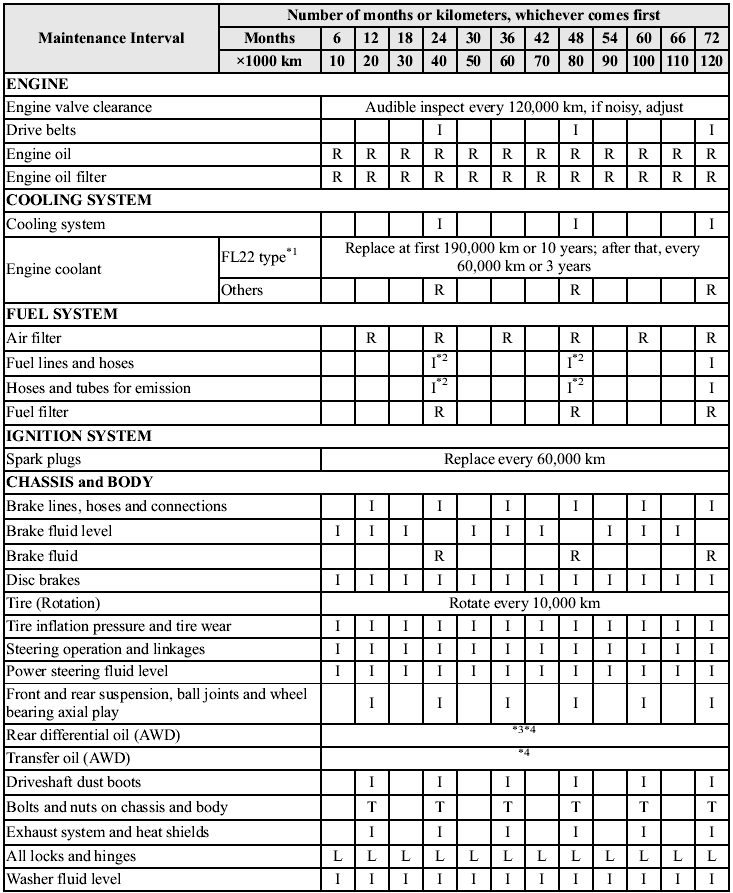

Chart symbols:
I: Inspect: Inspect and clean, repair, adjust, fill up, or replace if necessary.
R: Replace.
L: Lubricate.
C: Clean.
T: Tighten.
Remarks:
*1 Use FL22 type coolant in vehicles with the inscription УFL22Ф on the radiator cap itself or the surrounding area. Use FL22 when replacing the coolant.
*2 According to state/provincial and federal regulations, failure to perform maintenance on these items will not void your emissions warranties. However, Mazda recommends that all maintenance services be performed at the recommended time or kilometer period to ensure long-term reliability.
*3 If the vehicle is operated primarily under any of the following conditions, replace the rear differential oil at every 40,000 km.
a) Towing a trailer or using a car-top carrier.
b) Driving in dusty, sandy or wet conditions.
c) Extended periods of idling or low speed operation.
d) Repeated short trips of less than 16 km.
*4 If this component has been submerged in water, the oil should be replaced.
Schedule 2
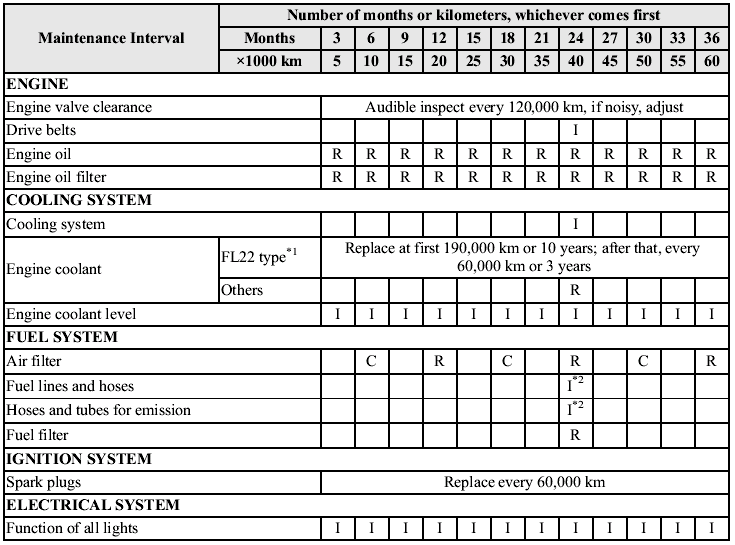
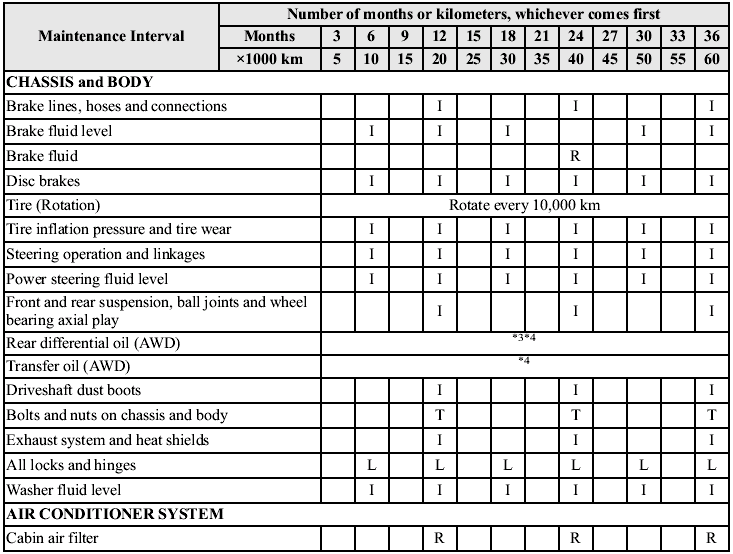
Chart symbols:
I: Inspect: Inspect and clean, repair, adjust, fill up, or replace if necessary.
R: Replace.
L: Lubricate.
C: Clean.
T: Tighten.
Remarks:
*1 Use FL22 type coolant in vehicles with the inscription УFL22Ф on the radiator cap itself or the surrounding area. Use FL22 when replacing the coolant.
*2 According to state/provincial and federal regulations, failure to perform maintenance on these items will not void your emissions warranties. However, Mazda recommends that all maintenance services be performed at the recommended time or kilometer period to ensure long-term reliability.
*3 If the vehicle is operated primarily under any of the following conditions, replace the rear differential oil at every 40,000 km.
a) Towing a trailer or using a car-top carrier.
b) Driving in dusty, sandy or wet conditions.
c) Extended periods of idling or low speed operation.
d) Repeated short trips of less than 16 km.
*4 If this component has been submerged in water, the oil should be replaced.
(Cont.)
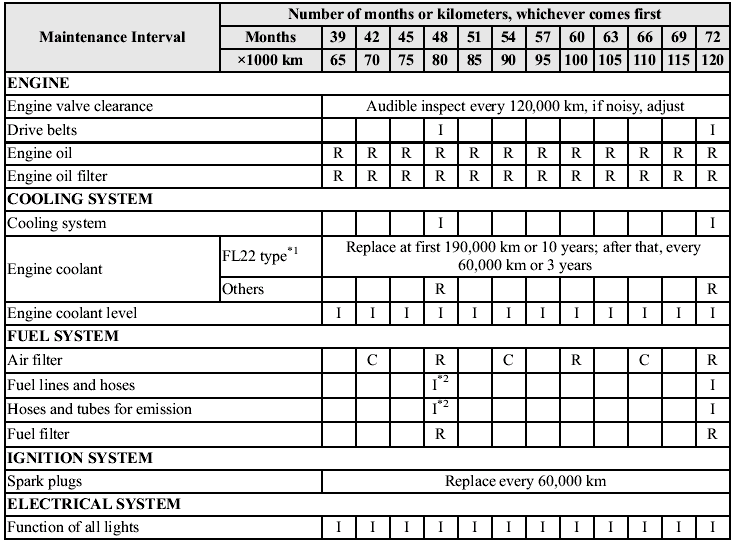
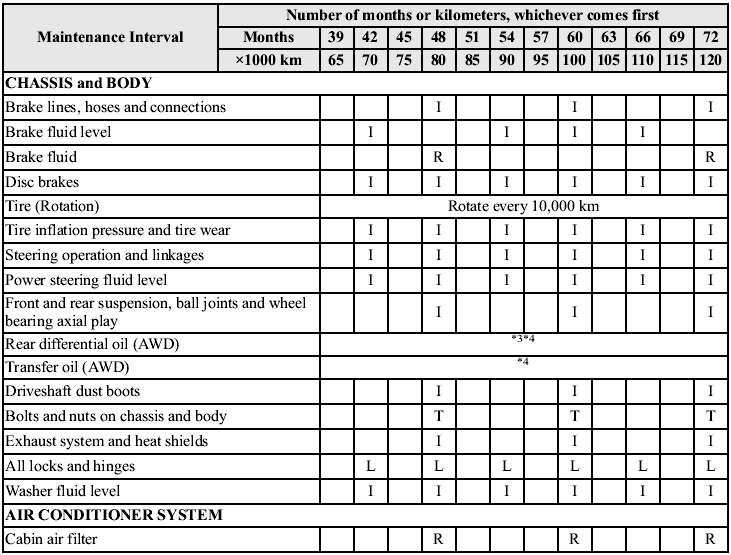
Chart symbols:
I: Inspect: Inspect and clean, repair, adjust, fill up, or replace if necessary.
R: Replace.
L: Lubricate.
C: Clean.
T: Tighten.
Remarks:
*1 Use FL22 type coolant in vehicles with the inscription УFL22Ф on the radiator cap itself or the surrounding area. Use FL22 when replacing the coolant.
*2 According to state/provincial and federal regulations, failure to perform maintenance on these items will not void your emissions warranties. However, Mazda recommends that all maintenance services be performed at the recommended time or kilometer period to ensure long-term reliability.
*3 If the vehicle is operated primarily under any of the following conditions, replace the rear differential oil at every 40,000 km.
a) Towing a trailer or using a car-top carrier.
b) Driving in dusty, sandy or wet conditions.
c) Extended periods of idling or low speed operation.
d) Repeated short trips of less than 16 km.
*4 If this component has been submerged in water, the oil should be replaced.
See also:
Turn and Lane-Change Signals
qTurn Signal
Move the signal lever down (for a left
turn) or up (for a right turn) to the stop
position. The signal will self-cancel after
the turn is completed.
If the indicator light continue ...
Vehicle Overview
Introduced for the 2007 model year, the CX-9 crossover is available in Sport,
Touring and Grand Touring trim levels, has a number of standard safety features
and can seat up to seven people in its ...
Keys
WARNING.
Do not leave the key in your vehicle
with children and keep them in a place
where your children will not find or
play with them:
Leaving children in a vehicle with the
key is dangerous. ...


